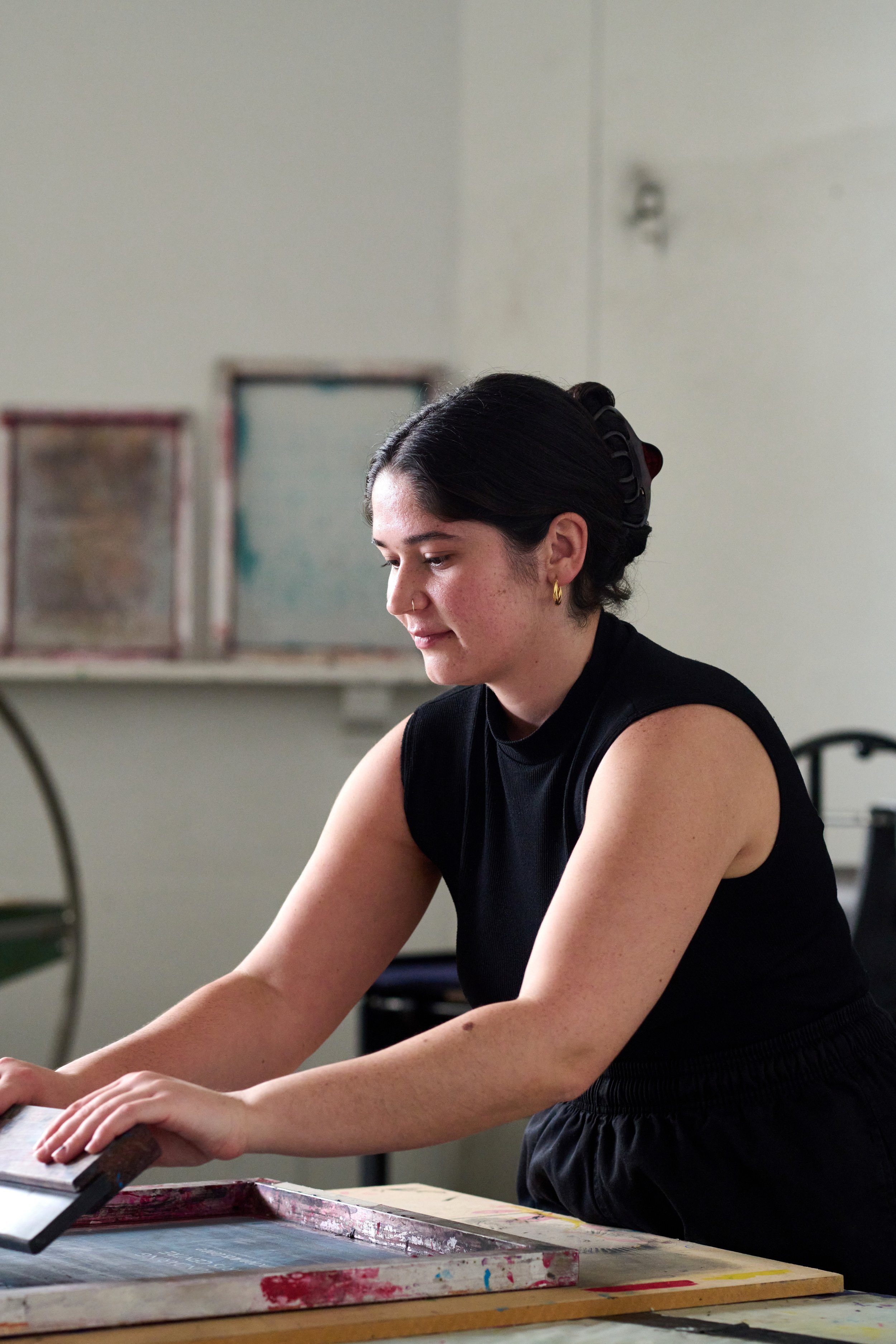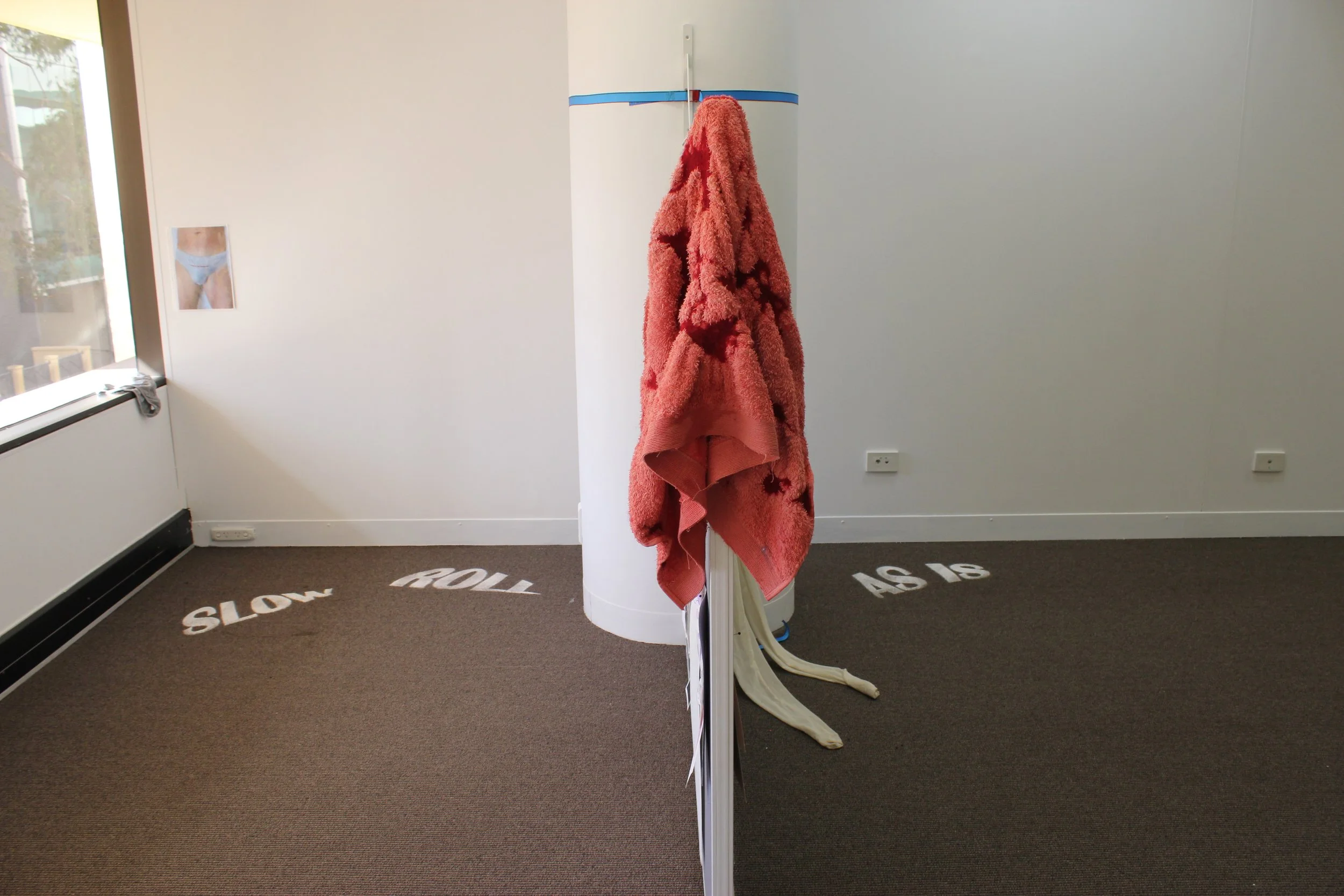Photography by Rebecca Mansell.
Elizabeth Knuckey
Elizabeth Knuckey is an emerging artist currently living and working on Whadjuk Noongar Boodja in Perth. Her practice is an exploration of ephemerality through text and water, often with mediums such as screen printing, installation, sculpture, video and audio.
Knuckey enjoys pushing the perimeters of printmaking, often working against the expectation of what print should be. Printmaking is so often concerned with archival quality and preservation. Knuckey is interested in what happens when you take traditional printmaking mediums and apply them to unconventional sites, knowing they aren’t meant to last. Rather than bringing a complete work to a location, she draws inspiration from the site itself to create something specifically for the place.
Tell us about your creative process. What drives your practice?
I’m driven by curiosity and how the boundaries of printmaking, and specifically screen printing, can move off the page. Conceptually I am interested in ephemerality and works that are intentionally temporary. I began working with text a few years ago, roughly the same time I learnt screen printing, and instantly took to it. This year I began exploring my love of the archive, enjoying the crossover between research and artwork. It’s been tickling my brain in a way that tells me I will definitely be working with it again. More recently I’ve been embracing the idea that what I do to feel fulfilled creatively is in it’s own way part of my practice. I’ve had some really lovely conversations with colleagues lately where we’ve discussed parts of our lives that aren’t exclusively art making, but feel in many ways like an extension of it. For me that’s been volunteering at local radio station RTRFM as an Assistant Producer.
What is the role of site-specificity within your work and how do you choose the locations you engage with?
Initially I chose spaces where I knew for certain the prints I did would not last more than a few months. Those were art school studio walls that get painted at the end of the year, wet areas where we clean screens, windows and bathroom mirrors. Following those locations, I was asked to screen print some text in places that might be seen as more permanent, but to me even if a work is on a wall for an extended period of time, eventually it will be painted over and removed. I’ve come to realise that the works I find the most fulfilling are the ones I can make for a site. Now I aim to draw as much from a site as I can and let a site inform a work, whether that’s through the size, composition, mediums, installation or the duration the work is displayed for. As a side note, if I had a dollar for every time someone has invited me into their house and asked me to screen print a work onto their toilet walls, I would have $2, which isn’t a lot but it’s funny it’s happened twice.
Can you tell us more about your exploration of ephemerality, especially in terms of preservation and expiry?
Printmaking is so often concerned with archival quality and preservation. We can spend so much of our time measuring something so it’s square or making sure layers are perfectly registered. I’m interested in what happens when you take traditional printmaking mediums and apply them to unconventional sites knowing they aren’t meant to last. For me, only working on paper feels restrictive, while moving off paper opens so many more possibilities. It helps me work quickly and stops me from being too precious with my work. I find if I know a print has a shelf life I can let go and focus on what I’m making, and the process of making the print, rather than only being concerned with what the end result will look like. Knowing a print will only exist for short periods of time allows me to feel more present with the work. While audiences may not know in passing that a print won’t be around for very long, I know and it helps make the work feel more intentional.
What inspires your writing practice and the text you compose for your screen prints?
I enjoy working with text from a range of sources. When I began the series of wall prints, some of the phrases were specifically requested, some were chosen and written by me, but I believe that all were collaborative. More recently I began the year as an artist-in-residence at CURRENT Gallery, Fremantle WA, where I read through archived newspaper articles and created artworks with direct quotes from the articles. It was a new experience using writing that wasn’t mine and recontextualising it decades after it was written. Another way I find text for my screen prints is by almost automatic writing in my journal. I will write pages and pages for as long as I need to in order to unclog all the distractions. I find as long as I keep writing, that one line of text or maybe only even one word I need will be in there somewhere.
Are there any female printmakers | artists that influence you?
Yes always! I will try to keep it concise. I am always blown away by the ways Amanda Bell uses text in her work, always so incredibly powerful and personal. I always feel reenergised when I revisit the work of Corita Kent and Garage Graphix Community Arts. I love the way they use subject matter and composition. Seeing the two embrace more traditional uses of screen printing to amplify awareness around contemporary social topics is inspirational. Learning about Barbara Kruger and Jenny Holzer was one of those moments where I can’t describe it any other way than everything just made sense. My printmaking tutors and technicians at university, who are all artists in their own right, opened my mind to art making in ways I could not have ever predicted, they were so pivotal in encouraging my experimentation. In particular Rachel Salmon-Lomas, who truly showed me how I want to move through the world, not just as an artist but as a person. Apologies for jumping all over the place, there’s so many women and so few words!
Finally, what exciting projects are you working on at the moment?
I feel very fortunate to be commissioned by More Than Reproduction for expand, contract, expand again. It has been a new experience because I’m making a work that is specific to the Print Council of Australia Gallery without having been in the space. I’ve found myself heavily relying on the team to tell me what the other participating artists are exhibiting and leaning into the restrictions of the gallery to inform the work rather than limit it. I’ve also been looking inward and treating my body as a site as well as the gallery when deciding what text is the most appropriate. It’s been a challenging and interesting new way to work! For the rest of the year, and into next year, I look forward to returning to archive. I have truly found a new love for it and hope to work between that intersection of art and archive on a more long term research-based project.



